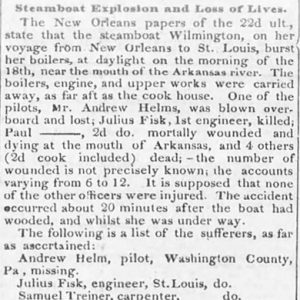calsfoundation@cals.org
Wilmington [Steamboat]
The Wilmington was a steamboat that burst a boiler while traveling on the Mississippi River near the mouth of the Arkansas River on November 18, 1839, killing several passengers and crew members.
Baltimore’s Watchman & Bratt firm built the Wilmington for the Raleigh Rail Road Company, working from a design by shipwright Langley B. Culley and launching the steamboat in early September 1839. The $60,000, 400-ton steamboat was 182 feet long and forty feet wide, with a ten-foot draft. Powered by a 135 horsepower Watchman & Bratt engine, the Wilmington (according to promotional material) “has one of Raub’s patented double self-acting safety valves, the first which has ever been introduced to operate successfully, on board of any boat on our waters.” The vessel held berths for 100 passengers.
The Wilmington, commanded by a Captain Gay, left New Orleans on November 11, 1839, and proceeded north up the Mississippi River. The steamboat stopped at Island 74 around 5:00 a.m. on November 18 to take on wood to feed the vessel’s boilers. About twenty minutes later, as the Wilmington continued its journey, the boat was shaken by a terrible explosion while near the mouth of the Arkansas River.
The vessel’s middle boiler exploded, hurling two other boilers overboard along with pilot Andrew Helm, who was never seen again. One newspaper reported that “the boilers, engine, and upper works were carried away, as far as the cookhouse,” while observers from another steamboat declared the Wilmington “the most desolate wreck which they have ever seen on the Mississippi River. The greater part of the machinery, the social hall, the cook house, wheel houses and entire gentlemen’s cabin had been swept away and nothing was left above the hull but a few scattered pieces of the boilers and a fragment of the ladies’ cabin.”
One passenger, in a letter to a Vicksburg, Mississippi, newspaper, alleged that even as passengers fought flames threatening to engulf the stricken vessel, Captain Gay called the Wilmington’s yawl, from which crew members were picking up people thrown by the blast into the river, to go back to the steamboat. He claimed the captain then got into the smaller boat and transported himself to shore, refusing to let others join him, and then sent the crew members sailing the yawl back to the Wilmington to get his personal chest and bring it to him. The passenger sent the letter to repudiate a statement signed by many fellow travelers immediately after the explosion that absolved Gay and the crew of any blame in the disaster.
The steamboat Marmion came across the wreck of the Wilmington about five hours after the explosion and took the wounded aboard, transporting them to Napoleon (Desha County). While accounts of casualties of the disaster vary, there were apparently around eleven people killed and as many as twelve injured.
Speculation of the cause of the explosion of the Wilmington ranged from the defective boiler “not [being] composed of good iron” to “the most common cause of all the steamboat disasters which we have heard of—a want of water in the boilers.”
The Wilmington catastrophe provides another example of the dangers of steamboat travel in Arkansas waters in the nineteenth century, where boiler explosions also caused mass casualties on the Car of Commerce in 1828, the Rob Roy in 1836, the Persian and Cherokee in 1840, the J. Wilson in 1853, the Sultana in 1865, and the Miami in 1866.
For additional information:
“Another Blow Up.” Vicksburg [Mississippi] Tri-Weekly Sentinel, November 27, 1839, p. 2.
Lloyd, James T. Lloyd’s Steamboat Directory and Disasters on the Western Waters. Cincinnati, OH: James T. Lloyd & Co., 1856.
“Steam-boat Explosion.” Southern Argus [Columbus, Mississippi], December 3, 1839, p. 2.
“Steamboat Accident.” [Lexington] Kentucky Gazette, December 5, 1839, p. 2.
“Steamboat Explosion and Loss of Lives.” National Gazette [Philadelphia, Pennsylvania], December 3, 1839, p. 2.
“Steamboat Explosion and Loss of Lives.” Fayetteville [North Carolina] Weekly Observer, December 11, 1839, p. 1.
“Steamboat Wilmington.” Charleston [South Carolina] Mercury, September 13, 1839, p. 2.
Mark K. Christ
Central Arkansas Library System


 Wilmington Steamboat Article
Wilmington Steamboat Article  Wilmington Steamboat Article
Wilmington Steamboat Article 



Comments
No comments on this entry yet.